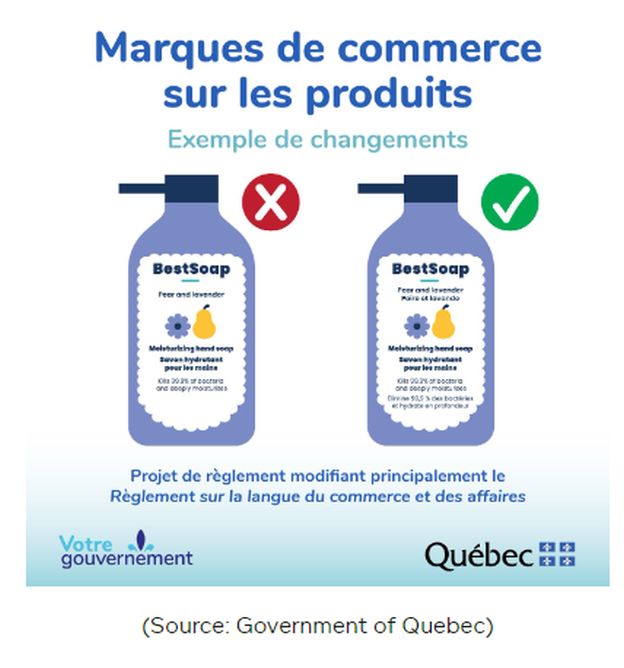This article is part of our series on recent amendments to the Charter of the French Language under Bill 96. Click here to read Part 2: Public Signage and Commercial Advertising.
Following the adoption by the Quebec National Assembly of Bill 96 in June 2022, which overhauled and strengthened French language requirements under the Charter of the French language in the province of Quebec (the "Charter"), both practitioners and businesses carrying on activities in the province have been waiting for an updated Regulation regarding the language and commerce of business. The much-anticipated draft regulation (the "Regulation") was finally published on January 10, 2024, shedding light on certain areas of doubt raised by Bill 96, while also raising some additional questions.1
Below is a summary of the key proposed changes regarding inscriptions on products. We invite you to also consult our additional articles on Commercial Advertising and Public Signage, as well as on the Language of Contracts.
No more exception for common law trademarks
For those who may be less familiar with Charter requirements, all inscriptions appearing on products, on their packaging or labelling, or on documents which accompany them, must by default be in French only, but may also appear equally in both French and another language.
One of the most significant changes brought by Bill 96 is to limit the ability to have a trademark appear on product packaging and labelling only in a language other than French to trademarks registered in Canada, such change being in effect from June 1, 2025. The Regulation definitively puts the nail in the coffin of the broader historical trademark exception, which previously extended to common law trademarks and allowed trademark owners to have their non-French trademark appear on products whether or not they were registered in Canada, as long as they could support an argument that such trademark mark could be "recognized" as such under the Canadian Trademarks Act (including, for example, by relying on the fact that the trademark was registered in another jurisdiction).
This change is meant to avoid having the representatives of the agency responsible for the enforcement of the Charter, the Office Québécois de la langue française ( "OQLF"), be in a position where they need to make a legal determination as to whether or not a trademark meets this qualification; the requirement for a registered trademark provides an objective criteria which is easy to apply and avoids having them engage in lengthy substantive communications which is outside of the scope of their expertise. As a result, the OQLF will not be able to issue and process notices of non-compliance more quickly, which is consistent with their current internal practice.
Limited relief for holders trademarks which may not yet be registered in Canada
The Regulation does bring some relief to trademark holders, as products that are not compliant with product requirements under s. 51.1 of the Charter may remain in the market until June 1, 2027, so long as they were manufactured before June 1, 2025 and no French version of the trademark is registered in Canada on the date the final version of this Regulation is published in the Gazette officielle du Québec (which is currently expected to be February 24, 2024).
Moreover, the recent publication confirms that for the purposes of this new requirement, trademarks for which an application for registration is pending are considered to be registered trademarks from the date of the filing of the relevant application. This allows owners of pending applications to breathe a sigh of relief given the current significant delays before a trademark application is even distributed for examination at the Canadian Trademarks Office.2
The regulation unfortunately does not provide any additional clarity on the required absence of a French equivalent of the trademark in question on the trademarks register; for example, would inactive or abandoned French language trademarks which still appear on the register impact the ability of the corresponding trademark in another language to appear on a product in the absence of its French counterpart?
Generic terms or descriptions included within a registered trademark
One of the other key changes to the Charter included in Bill 96 is the requirement, from June 1, 2025, to have any generic term (words describing the nature of a product) or a description of the product (words describing the characteristics of a product) included in a registered trademark appear in French on the product or on a medium that is permanently attached to it.
This change is meant to curb what had become a common practice to file trademark applications for additional product information surrounding a core trademark, to avoid translation of same in French and rely on the trademark exemption. By requiring the translation of the generic terms or descriptions, the Charter aims to ensure that French speaking purchasers of those products have access to the same information as other non-French speaking purchasers.
First of all, while this new Section 51.1 of the Charter only referred to this requirement as applying to "the product", the Regulation does confirm that the definition of a "product" does include its container or wrapping and any document or object supplied with it (as per the language of the general requirement set out in Section 51 of the Charter). However, it does not provide any additional insight on the scope of what is captured by the term "medium permanently attached to the product" in the context of trademark and labelling requirements under s. 51.1 of the Charter.
While Section 51.1 of the Charter did not prescribe how the French version of the generic terms or description were to appear on the product, the Regulation also provides that no such generic term or description of a product included in a trademark in another language may be given greater prominence than that in French, nor may they be made available on more favourable terms. While we are still waiting for the release of formal guidance from the OQLF following publication of the draft Regulation, the Government of Quebec published the following visual on the social media platform X to assist in the understanding of their expectations:

In the example above, even if the "Pear and Lavender" description has been included in the registered trademark, the new rules would still require that it be translated in French. We note that in this particular example, the trademark "BestSoap" itself is not translated in French on the right hand side, even though "Best" could be considered to be a generic term, and "soap" a description of the product. It will therefore remain to be seen how the OQLF will enforce this new rule going forward.
Extension to embedded software
The Regulation indicates that for the purposes of section 51 of the Charter, an inscription on a product (i.e. requiring a French language equivalent) includes the inscription displayed for the user using an integrated software. For example, if information about a product is only accessible through a software embedded in the product itself, this information would also be deemed to be an inscription "on" such product. This is consistent with the overall objective of having the French-speaking purchaser have access to the same relevant information.
How Can We Help?
As the regulatory landscape continues to evolve, non-compliant behavior is simultaneously being confronted with increasing scrutiny by the Office québécois de la langue française. As the Regulation fully enters into force on June 1, 2025, enterprises carrying on activities in Quebec should use the year and a half ahead to assess their risks accordingly and proactively address any gaps between existing practices and obligations under the law.
McCarthy Tétrault LLP's regulatory team is here to help your business navigate this rapidly evolving regulatory area, offer practical guidance on how to engage with regulators, and ensure that your practices are compliant with all applicable laws, regulations, and industry requirements. To learn more about how we can support you, please contact Véronique Wattiez Larose, Jessica Cytryn or Vino Wijeyasuriyar.
Footnotes
1. Please note that the Regulation is currently in the 45-day public consultation period during which comments on the proposed changes may be submitted to the Minister of the French Language. The final version of the Regulation may therefore differ from the changes summarized here.
2. Canadian Intellectual Property Office, Trademarks, online: https://ised-isde.canada.ca/site/canadian-intellectual-property-office/en/trademarks
The content of this article is intended to provide a general guide to the subject matter. Specialist advice should be sought about your specific circumstances.



